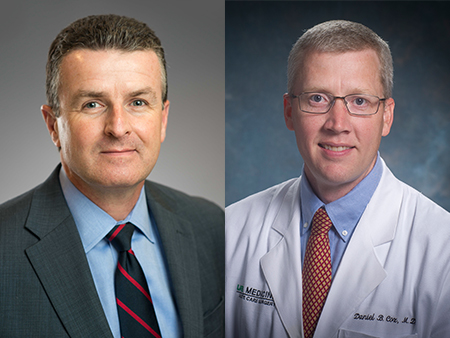 The number of patients seen at the UAB trauma center continues to rise, requiring increased investment in people and resources to provide treatment.The news is full of stories about trauma: shootings, wrecks, injuries. The number of traumatic injuries seen at the University of Alabama at Birmingham Hospital trauma center keeps going up. Trauma awareness has never been more important — so important that the hospital is turning one normally green UAB sign red to highlight Trauma Awareness Month, running through May.
The number of patients seen at the UAB trauma center continues to rise, requiring increased investment in people and resources to provide treatment.The news is full of stories about trauma: shootings, wrecks, injuries. The number of traumatic injuries seen at the University of Alabama at Birmingham Hospital trauma center keeps going up. Trauma awareness has never been more important — so important that the hospital is turning one normally green UAB sign red to highlight Trauma Awareness Month, running through May.
“The trauma center in the Division of Trauma and Acute Care Surgery has seen double-digit increases in the number of trauma cases every year over the past three years,” said Daniel Cox, M.D., trauma medical director at UAB. “Overall, we’ve seen an increase of 20 percent in trauma evaluations at the hospital since 2018.”
Cox says a lot of those are penetrating injuries, the kinds associated with gunshot wounds or stabbings.
“We saw 604 cases of gunshot wounds in 2013,” Cox said. “In 2020, that number jumped to 1,056. Roughly 20 percent of all cases we see are penetrating injuries. The others are blunt force injuries, commonly seen in motor vehicle crashes or falls.”
The increase in volume is daunting. The most patients ever seen by the trauma center in one 24-hour period was 45, following the 2011 tornado outbreak in Alabama. Cox says that, over Easter weekend 2021, the team treated 38 traumas on Saturday alone.
“For the tornado response, we brought in additional surgeons, nurses and other medical staff to handle that heavy volume,” Cox said. “But as we have become accustomed to increasing volumes, the Easter experience was really just business as usual.”
“We have had to expand our staffing and our resources over the past five years to keep pace with the need,” said Jeffrey Kerby, M.D., Ph.D., director of the division of Trauma and Acute Care Surgery in the Department of Surgery. “We are the only American College of Surgeons-verified adult Level I trauma center in the state of Alabama, and we are always open. We would love to put ourselves out of work; but we know the reality is people will get hurt, and we have to be there with the appropriate resources to treat those patients.”
 Jeffrey Kerby, M.D., Ph.D., director of the Division of Trauma and Acute Care Surgery (Photography: Dustin Massey), and Daniel Cox, M.D., trauma medical director (Photography: Steve Wood)If there is a bright spot to these grim statistics, it is that the trauma center maintains a 95 percent survival rate. A patient who makes it to UAB Hospital alive is overwhelmingly likely to survive. But Kerby and Cox stress that boosting awareness and preventing injuries in the first place is the most important goal. Turning the green UAB sign on the Sixth Avenue parking deck red is just one striking way to deliver that message.
Jeffrey Kerby, M.D., Ph.D., director of the Division of Trauma and Acute Care Surgery (Photography: Dustin Massey), and Daniel Cox, M.D., trauma medical director (Photography: Steve Wood)If there is a bright spot to these grim statistics, it is that the trauma center maintains a 95 percent survival rate. A patient who makes it to UAB Hospital alive is overwhelmingly likely to survive. But Kerby and Cox stress that boosting awareness and preventing injuries in the first place is the most important goal. Turning the green UAB sign on the Sixth Avenue parking deck red is just one striking way to deliver that message.
“That’s the goal of Trauma Awareness Month: to encourage people to take safety precautions and avoid injuries,” Kerby said. “We are here and ready when the inevitable injuries happen; but we’d prefer to see these injury numbers go down, rather than keep going up.”
UAB is also heavily involved with a national program called STOP THE BLEED®. Organized by the American College of Surgeons, STOP THE BLEED® provides training and materials so that in the event of a traumatic and bleeding injury, properly trained and equipped bystanders can save someone’s life. May 20 is National STOP THE BLEED® Day, a one-day call to action urging families, schools, businesses, places of worship or other organizations to prepare.
For more information on how to participate, visit:
- Sign up:https://nationalstopthebleedday.org/about
- Get trained:https://nationalstopthebleedday.org/get_trained
- Get kits:https://nationalstopthebleedday.org/get-kits-2/
- Get the facts: How much do you know about tourniquets? Take a quiz today to test your knowledge!https://stopthebleed.usuhs.edu/
The Division of Trauma and Acute Care Surgery employs 20 trauma surgeons. Additionally, the division trains up to 40 residents and four fellows in trauma care each year. The team maintains nurse practitioners, physician assistants, a physiatrist, clinical coordinators, epidemiologists, and case managers/social workers. Nurses trained specifically in trauma care work in multiple areas throughout the hospital, including the emergency department, trauma/burn intensive care unit, the neurosurgical intensive care unit, trauma/burn nursing unit, and acute trauma care unit.